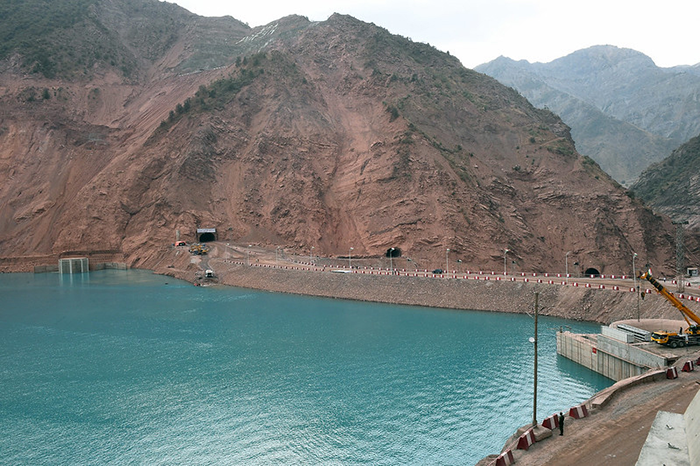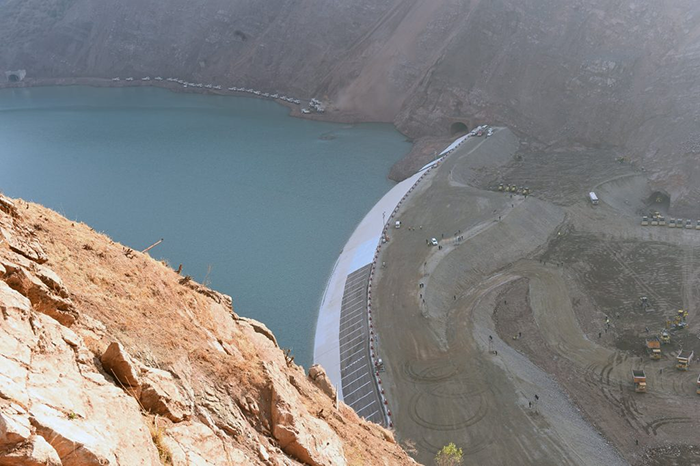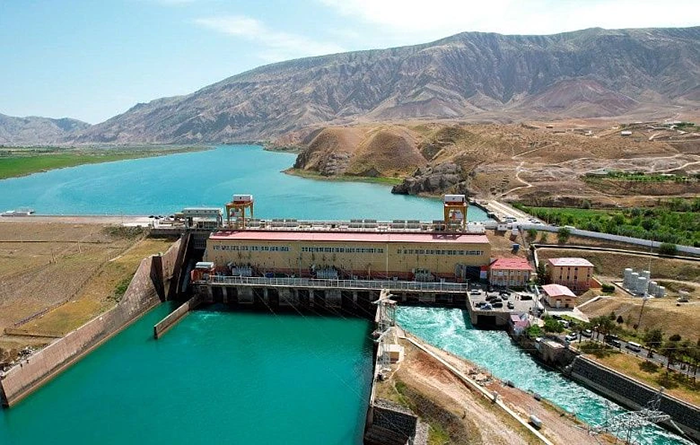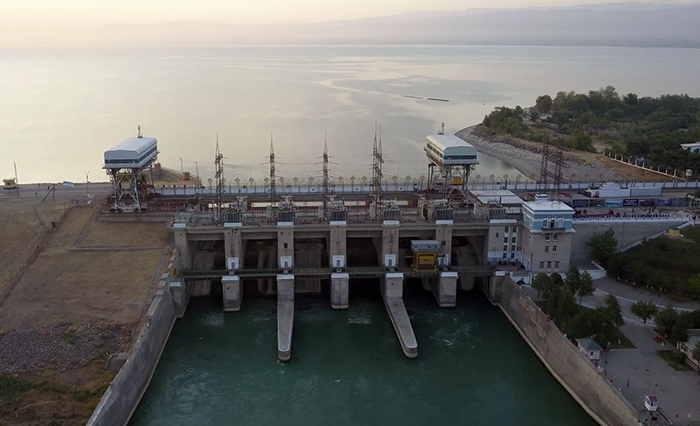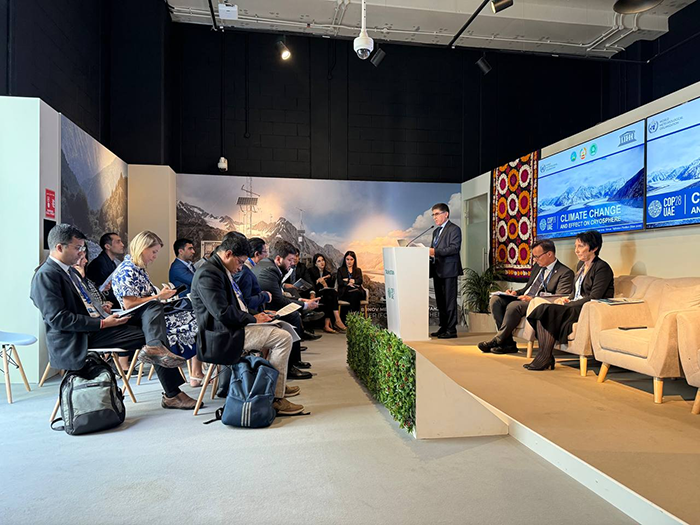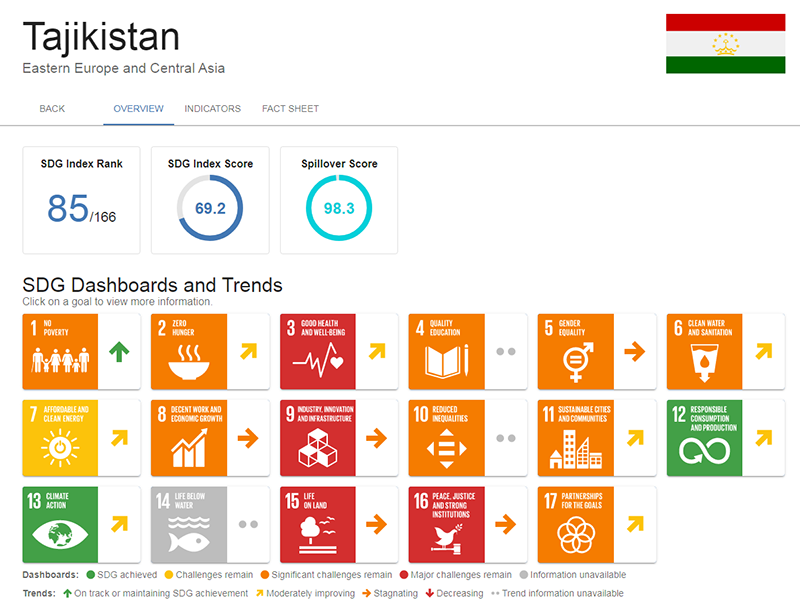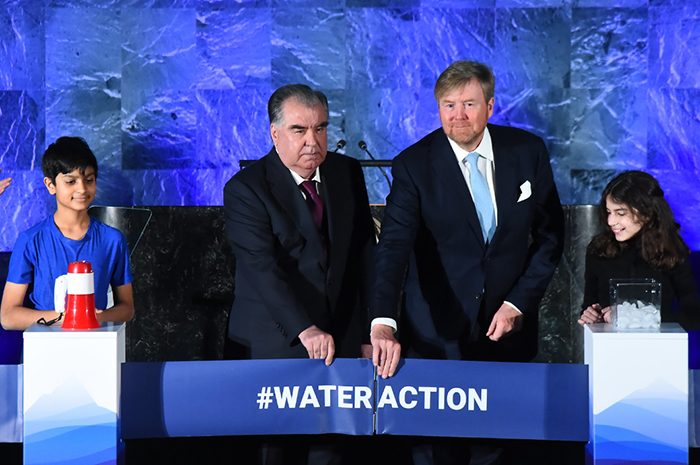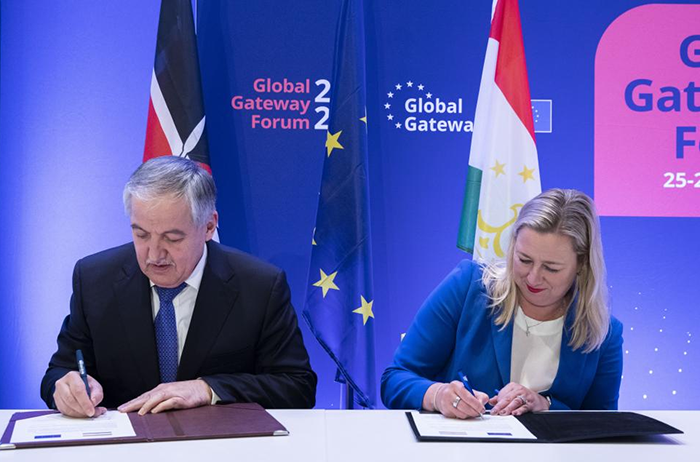
Section 5. Key water developments in the countries of Central Asia
5.3. Republic of Tajikistan

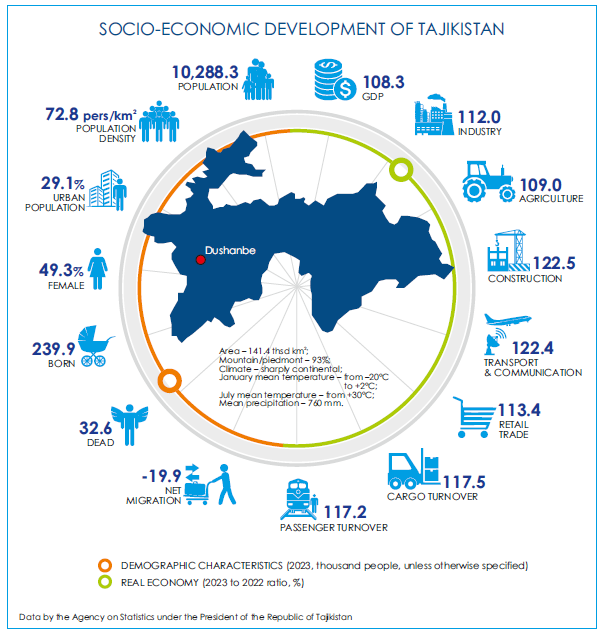
Water sector
Water resources. In Tajikistan, the main water resources are glaciers, rivers, lakes, reservoirs and groundwater. There are 14,509 glaciers, with a total glacial area of 11,146 km2 (approximately 8% of the country's territory) and a total ice volume of about 845 km3. The country is crisscrossed by 947 rivers, stretching over 28,500 km in total. The average annual river runoff is 64 km3/year, (80% from the Amu Darya River and 1% from the Syr Darya River). This accounts for 55.4% of the long-term average annual runoff in the Aral Sea basin. Tajikistan boasts approximately 1,300 lakes, covering a total area of 705 km2. These lakes hold over 46.3 km3 of water, including 20 km3 of fresh water. The country's 11 reservoirs cover a total surface area of 664 km2 and hold a total capacity of 15,344 km3. Their usable capacity, amounting to 7.63 km3, represents 13% of the long-term average annual runoff in the Aral Sea Basin. The country's potential groundwater stock is 18.7 million km3 per year, with usable resources estimated at 2.8 km3 per year. Additionally, over 200 mineral springs and 100 geothermal water deposits have been identified.
The main water consumer in Tajikistan is irrigated agriculture, which accounts for 85% of total water use. Household and drinking water supplies account for 5%, industry - 5%, fishing - 2%, and other sectors - 3%.
Latest developments in legislation. The "Investment Program to Provide Pumping Stations of the Agency for Land Reclamation and Irrigation at the Government of Tajikistan with Modern Energy-Saving Equipment for 2023-2027" worth 889,670 thousand TJS has been adopted (PP RT No. 296 of 30.06.2023). Modern energy-saving equipment will be installed at 36 pumping stations between 2023 and 2025, at 16 pumping stations in 2026, and at 7 pumping stations in 2027.
New appointments. Mr. Z.Davlatzoda was appointed as the Director of the Agency for Land Reclamation and Irrigation under the Government of the Republic of Tajikistan (PP RT No. 7 of 5.01.2023) and Mr. Kh.Z.Zarifzoda and Mr. A.Safarzoda were appointed as First Deputy Directors of the Agency (PP RT No. 105 and 106 of 16.03.2023).
State programs and projects. Ongoing/completed projects: (1) 2016-2025 Water Sector Reform Program; (2) Irrigation Land Reclamation Program of the Republic of Tajikistan, 2019-2023 (PP RT No. 374 of 01.08.2018); (3) State Program for Development of New Irrigation Land and Rehabilitation of Withdrawn Agricultural Land (PP RT No. 90 of 01.03.2022), according to which more than 11,000 ha of new irrigation land are to be developed by the end of 2027 and more than 5,000 ha of land withdrawn from agricultural production will be reclaimed. 563 million TJS are allocated for these purposes. In 2023, out of 1,547 ha planned new irrigated land and 480 ha of re-introduced land, 3,082 ha (199%) and 1,092 ha (228%) were developed and reclaimed, respectively.
MEWR RT maintains and develops the National Water Information System.
Ongoing projects: Improvement of Water Resources Management in Khatlon Province (IsDB, $53.5 million, 2020-2024); Water Resources Management in the Panj River Basin (ADB, $46.610 million, 2017-2024); Climate- and Disaster-Resilient Irrigation and Drainage Modernization in the Vakhsh River Basin (WB, $35.2 million, 2022-2027).
New projects: (1) Strengthening Water and Irrigation Management in Tajikistan (WB, EU, $47.34 million, 2022-2027) aims to enhance capacities in water resource planning and irrigation management in Tajikistan and improve efficiency of selected irrigation systems in the Vakhsh and Zerafshan River basin zones; (2) Enhancing economic independence and Improving the situation of women in Central Asia through access to irrigation water and infrastructure (Coca-Cola Foundation, more than $500 thousand). The project will cover Bokhtar district in Khatlon province and Vakhdat district in Tajikistan.
Tajikistan signed an agreement with the EDB for a $32 million loan for the project "Irrigation System Renovation to Increase the Capacity of Irrigation Systems in Zafarabad District in Sogd Province" (2024-2029) aimed to improve the efficiency and sustainability of the irrigation system in this region.
Events. Several events were organized in the course of the year, including: (1) 84th ICWC meeting (Dushanbe, May 10); (2) International Conference "Central Asia: Towards a Sustainable Future through a Strong Regional Institution" dedicated to the 30th Anniversary of IFAS (Dushanbe, June 6); (3) joint meeting of the Working Group on IWRM and the Coordination Working Group on Implementation of the Tajikistan Water Sector Reform Program, where ongoing reforms were discussed, including the finalized draft "National Water Strategy for Tajikistan until 2040", the institutional structure for coordinating the water sector in the Republic of Tajikistan, and the finalized draft Concept on Integrating Basin Water Resources Management Plans into Development Plans and Programs for Cities and Districts in Tajikistan (Dushanbe, November 23); (4) a special session on contribution of the Tajikistan Water Sector Reform Program to climate change adaptation and sustainable development of the water sector (Dubai, UAE, December 5).

November 27, 2023, Dushanbe Source
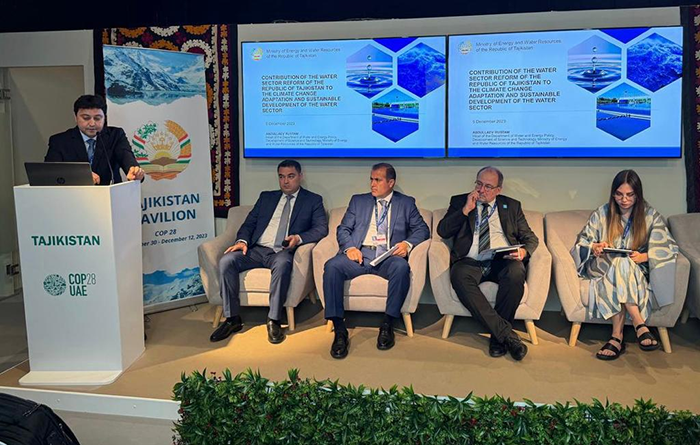
December 5, 2023, Dubai Source
The staff of the MEWR RT and Administration of Water Resource Management in the Republic of Tajikistan received training in GIS, information technologies, applications of the National Water Information System (NWIS), and other topics (August 21-26, November 20-25), glacio-hydrological modeling NS water distribution in the Zerafshan River basin in Tajikistan (September 25-28, December 5-7), and a one-day training session with Dr. Sonu Kanal, a SPHY modelling trainer (December 19). They also attended a training course on sustainable groundwater management (Tashkent, March 14-15).
The Tajikistan's delegation participated in the UN Water Conference (New York, March 22-24) and World Water Week (Stockholm, Sweden, August 20-24).
Drinking Water Supply
Access to drinking water supply and tariffs. According to the State Unitary Enterprise (SUE) "Housing and Communal Services", 66% of the population now has access to centralized water supply, representing a 6.3% increase from the previous year. This improvement has resulted in 6.742 million people gaining access to clean drinking water, a substantial increase of 1.618 million individuals. Drinking water tariffs are 1.09 TJS per 1 m3 for population, 2.02 TJS for budget organizations, and 3.48 TJS for commercial enterprises. For sewerage services, population pays 0.55 TJS, budget organizations - 1.09 TJS, and commercial enterprises - 1.88 TJS per 1 m3.
New appointments. Mr. A.A.Dostizoda was appointed as the First Deputy Director General of the SUE "Housing and Communal Services" (PP RT No. 149 of 17.04.2023) and Mr. R.A.Rasulzoda, as the Deputy Director General (PP RT No. 150 of 17.04.2023).
State programs and projects. As a result of implementation of the past program prior to 2021 and the current "Development Program of Housing and Communal Services in the Republic of Tajikistan, 2021-2024" (PP RT No. 53 of 27.02.2021), thanks to cooperation with several international financial organizations, access to clean drinking water for the population increased from 43% to 65.8%. Thanks to several key projects, including the Rehabilitation of Water Supply System in Cities of Khatlon province (IsDB, Yavan and J.Balkhi districts), Reconstruction of Cities in Northern Tajikistan (Istiklol, Buston, Guliston, Khorog, Kanibadam, and Isfara cities, B. Gafurov district), and Reconstruction of Cities in Northern Tajikistan-2 (Istaravshan and Penjikent cities, Shahristan and Zafarabad districts), significant strides have been made in improving access to clean drinking water. Over 534,740 people now have access to clean drinking water, and more than 162,000 people have gained access to water in general. In B.Gafurov district, the first phase of the Rehabilitation and Construction of Drinking Water Supply Networks in Zarzamin Rural Council project was recently completed, benefiting 7,000 residents with clean drinking water. Additionally, a new water pipeline was inaugurated in Kahramon village, providing water to over 180 households.
The "Water Supply and Sewerage in Kulyab City" project (€16.25 million) has provided significant support to the State Enterprise of Water Supply and Sewerage in Kulyab City. This includes the transfer of 9 units of special engineering equipment, 5 pieces of equipment, and 10,650 water meters. Additionally, the project has assisted with hydrogeological surveying to improve water resource management.
The "Rural Water Supply and Sewerage" project (WB, $58 million, 2019-2025, Vose, Vakhsh, Kushoniyon, J.Balkhi, Levakant, Dusti, and Jaihun cities) is currently underway in 7 districts of Khatlon province. This project is providing consultation services for the development of the Drinking Water Supply and Wastewater Disposal State Program up to 2030 and building the capacity of local communities. Furthermore, the project is actively engaged in the construction and equipping of water supply facilities in these districts.
Other ongoing projects: (1) USAID Rural Water Supply Activity (2020-2025): a pumping station in the Zaynabobod village of Rudaki district and a drinking water supply system in Soycha village of B.Gafurov district were rehabilitated; (2) Investments in Water Supply and Sanitation in Tajikistan (IDA, $45 million, 2022-2027) and others.
Agriculture
2023 Results The gross agricultural product increased by 9.027 billion TJS, representing a 1.8% growth rate. Agriculture now contributes over 24.6% to the country's GDP. The total agricultural output surpassed 63 billion TJS, marking a 9% increase compared to the previous year. This growth can be attributed to both crop and livestock production. Crop production reached 43.37 billion TJS, a 6.8% increase, while livestock production surged to 19.66 billion TJS, a 14.1% increase.
85% of the cotton plan was fulfilled: 344,400 tons of cotton were harvested, slightly below the forecast of 429,600 tons. A grain harvest of 1.754 million tons was achieved, exceeding the forecast of 1.67 million tons by 5%. The area under crops increased by 1,800 hectares to over 392,000 hectares.
Approximately 178,000 tons of agricultural products were exported, a decrease of 13,000 tons compared to the previous year . Despite a record fruit harvest of 665,000 tons (a 30% increase), Tajikistan imported over 44,000 tons of fruit, a 6.7% increase. Wheat imports increased by 48,000 tons to over 975,000 tons and rice imports increased by 5,500 tons to 33,000 tons.
Latest developments in legislation. The following documents were approved: (1) "Program of Agro-Food System Development and Sustainable Agriculture up to 2030" (PP RT No. 54 of 01.03.2023); (2) a new procedure for issuing, replacement and canceling of land share certificates aimed at ensuring favorable conditions for exercising the right to land use, establishing farms, determining the size of a land plot and land share, and overcoming existing problems (Resolution of the Chairman of the State Committee for Land Management and Geodesy of RT, No. 32 of 15.05.2023).
New appointments Mr. K.Khakimzoda was appointed as the Minister of Agriculture of the Republic of Tajikistan (PP RT No. 493 of 05.01.2023); Mr. D.Nosizoda was appointed as the First Deputy Minister (PP RT No. 322 of 18.07.2023); and, Mr. M.F.Nazarzoda was appointed as the Deputy Minister (PP RT No. 323 of 18.07.2023).
Programs and projects. Ongoing programs: "Pasture Development Program for the Republic of Tajikistan, 2023-2027" (PP RT No. 579 of 29.11.2022) aimed to increase natural pasture areas by applying modern technologies and improve pasture productivity; "Concept for Creation and Development of Agro-Industrial Clusters in the Republic of Tajikistan up to 2040" (PP RT No. 566 of 28.10.2020) and the "Program of Agro-Food System Development and Sustainable Agriculture up to 2030" (see above) approved in 2023. Several investment projects make a significant contribution to these programs, including: Strengthening Resilience of Agriculture Sector (WB, 2021-2026) by increasing the availability of quality seeds, climate-resilient seedlings, improving access to agro-logistic services for farmers and agribusinesses, and improving the public governance institutions; Community-Based Agricultural Support (IFAD, 2023-2030, 16 districts in Khatlon province, 3 districts of central subordination and 2 districts in Sogd province).
The Towards Rural Inclusive Growth and Economic Resilience/TRIGGERII project is underway (EU, BMZ, GIZ). The project aims to strengthen economic resilience of micro-, small- and medium-sized enterprises (MSMEs), including small farmers, young entrepreneurs and women entrepreneurs: farmers have got agricultural equipment in four rural communities (Lakhsh, Lakhshi Bolo, Surkhob, Sari Tal) in Lakhsh district; startup and entrepreneurship financing program has been launched in the Rasht and Zerafshan valleys; training for trainers on launching an incubation program for startups (July 3, Nurek) and a number of meetings (August 1-6, 15-21, and 21-26) were held; a Conference on the occasion of the International MSMEs Day (6 July), a meeting to present the results of the Rasht Valley project (18 July, Garm), and a meeting with start-up entrepreneurs (1 November, Khujand) were organized, etc.
USAID launched: (1) Market Driven Rural Development Project/MDRD ($19 million, 2022-2027). This is a Nationwide Activity that accelerates agricultural sector growth to enable inclusive access to economic opportunities in rural communities; (2) Tajikistan Food Security Net Activity ($10 million, 2022-2027).
As part of the USAID Feed the Future Program, the following projects are implemented: (1) Tajikistan Evaluation and Analysis Activity/TEAA ($3 million, 2022-2025) aimed to raise incomes of the rural poor and improve food and nutrition security; (2) Agriculture and Land Governance Activity (more than $36 million, 2020-2025, 12 districts in Khatlon province) to accelerate agriculture-led growth, deepen resilience among vulnerable populations, enhance the enabling environment for agriculture and land reform, and improve nutrition.
In Dushanbe, the final results were announced for the EU's Enhanced Competitiveness of Tajik Agribusiness Program (EBRD, loans for $24.5 million, grants for €5.65 million, 2014-2023) (May 26) and the USAID Entrepreneurship and Business Environment Development Project ($18.6 million, 2018-2023, Khatlon province) (May 30).
Events and international cooperation. Agricultural products of Tajikistan were presented at the 87th "International Green Week" exhibition (January 20, Berlin). The Bactria Food 2023 Export Forum brought together key players from the public and private sectors to discuss and address challenges in exporting agricultural products (Bokhtar, Khatlon province, May 25).
Within the framework of the state visit of Turkmen President to Tajikistan, 23 documents were signed, including the "Roadmap for Expanding Cooperation in Agriculture for 2023-2025" between the Tajik MA and the Turkmen MAEP (Dushanbe, May 10).
Agricultural cooperation issues were discussed during the meeting with the head of the Turkish Cooperation and Coordination Agency (TIKA) in Tajikistan (Dushanbe, November 9) and on the margins of the 19th meeting of the Tajikistan-Russia Intergovernmental Commission on Economic Cooperation (Moscow, December 18).
Energy
Energy production and export. Tajikistan possesses hydropower resources estimated at 527 billion kWh per year. However, currently, only a small fraction (4-5%) of this potential is being harnessed. The country's hydropower infrastructure comprises 11 large and medium-sized hydropower plants (HPPs) and approximately 300 smaller ones, with a combined installed capacity of about 5,500 MW.
In 2023, Tajikistan generated 21.656 billion kWh of electricity, a 2.1% increase compared to the previous year. This increase was driven by a 453 million kWh boost in production. Tajikistan also increased its electricity exports by 4.9% to 2.6 billion kWh. The primary destinations for these exports were Afghanistan (1.6247 billion kWh), Uzbekistan (907.5 million kWh), and Kazakhstan (144.6 million kWh). Despite this, Tajikistan still imported 18.6 million kWh of electricity from Uzbekistan and Kyrgyzstan.
Latest developments in legislation. The "2023-2027 Renewable Energy Program" aimed at achieving energy independence and the Action Plan for 2023-2025 for its implementation were approved in March (PP RT No. 51 of 01.03.2023) . It is anticipated that the implementation of the Program will increase the production capacity of the country's energy system by 32.2 MW through the utilization of Renewable Energy Sources (RES), including water, solar, and wind power.
By embracing a green economy, Tajikistan aims to become a global leader in renewable energy generation and a major exporter of electricity in the region. The "Strategy of Green Economy Development in the Republic of Tajikistan, 2023-2037" and its accompanying Action Plan for 2023-2025 outline the key steps to achieve this ambitious goal (PP RT No. 482 of 30.09.2022).
Hydropower Construction and Modernization
Rogun HPP. According to the MEWR RT, $1 billion is allocated annually (on average) to finance the construction of the Rogun HPP. Construction is carried out exclusively at the expense of state funds. In 2023, 5 billion TJS ($456 million) has been allocated. According to the latest estimates, $6.2 billion will be needed to complete the plant . Funds from international financial institutions are expected to be raised. In particularly, there are agreements to attract a soft loan from the Asian Infrastructure Investment Bank/ABII (PRC) in the amount of $500 million; an agreement was signed with the Saudi Fund for Development to provide a $100 million loan (Dushanbe, December 4); EDB plans to channel $130 million in 2024; a grant agreement was signed with the IDA to implement the draft structure and business framework of the Roghun project to improve its environmental and social sustainability, transparency and support its implementation ($15 million).
As of now, two units of the Rogun HPP are operational, generating approximately 7 billion kWh of electricity since their commissioning. The third unit is scheduled to become operational in 2025. The entire construction project is expected to be completed by the end of 2031.
Construction of Yavan HPP and Fandaryo HPP on the Zerafshan River. In June 2022, Tajikistan and Uzbekistan initiated the first phase of a joint hydroelectric power plant construction project, focusing on geological exploration and survey work. To oversee this project, a new operator company, "Tad-Uz Hydro," was established. The second phase will involve conducting a feasibility study to determine the project's final cost. The initial plan is to construct the 140 MW Yavan HPP, estimated to cost approximately $282 million. Subsequently, the parties will proceed with the construction of the 135 MW Fandaryo HPP, projected to cost around $270 million.
Following its reconstruction in April 2023, the Sarband HPP commenced full operations. The commissioning of the final 38 MW unit boosted the plant's generation capacity from 160 MW to 270 MW.
Kairakkum HPP. In 2023, two units of the hydropower plant were repaired and recommissioned, generating a combined capacity of 58 MW. This is equivalent to the output of three previous units. Additionally, repairs were completed on units 6 and 5, and reconstruction work on unit 4 commenced. All repair and reconstruction efforts are expected to be finalized by 2025.
CASA-1000. At the COP28 climate summit in Dubai, Energy Ministers from Tajikistan, Pakistan, and Kyrgyzstan announced that the CASA-1000 project is nearing completion. They signed a statement reaffirming their commitment to accelerating the implementation of this crucial energy project. Furthermore, during the conference, the President of Tajikistan met with Ajay Banga, President of the World Bank Group, to discuss the importance of reviving the CASA-1000 power transmission line project. This project aims to connect the energy markets of Central and South Asia through Afghanistan.
Tajikistan and the World Bank have signed grant agreements for additional funding to support the CASA-1000 project: (1) CASA-1000 Regional Power Transmission ($11 million): This funding will be used to facilitate the transfer of surplus electricity from Tajikistan and Kyrgyzstan to Afghanistan and Pakistan during the summer months. Additionally, it will support the development of electricity trading mechanisms and the establishment of a regional electricity market in Central and South Asia; (2) CASA-1000 ($10 million): This grant will be allocated to improve the quality and accessibility of electricity services, enhance socio-economic infrastructure, and support capacity building for local governments in communities within the project area.
Alternative Energy
Tajikistan has set a goal of reaching 10 GW of RES capacity by 2030. The country possesses vast renewable hydropower resources, with the potential to generate more than 3.5 times the current electricity consumption of the entire Central Asia region. In addition to hydropower, Tajikistan is exploring other renewable energy sources like solar, wind, biomass, and thermal energy. These sources are projected to contribute approximately 10% of the country's total energy needs.
Small hydropower. Over 285 small HPPs have been registered in Tajikistan, with capacities ranging from 5 kW to 4,300 kW. Some of the largest among these include: Marzikh (4,300 kW) in Ayni district, Sangikar (1,000 kW) in Rasht district, Pitovkul-2 (1,100 kW) in Jirgital district, and Kukhiston (500 kW) in Gorno-Matcha district. Small Khatfat HPP has been put into operation in Savnab village, Rushan district.
Solar power. The government plans to construct several SPPs with a combined capacity of 730 MW in the coming years. In the initial phase, five SPPs with a total capacity of 430 MW are slated for development.
Construction of a 600 kW SPP has already commenced in Murghab, Gorno-Badakhshan Autonomous Oblast (GBAO). Additionally, plans are underway to build a 200 MW SPP in the Sogd province.
Climate Change, Glaciers and Environmental Protection
Latest developments in legislation The "State Environmental Program of the Republic of Tajikistan for 2023-2028" and its accompanying Action Plan for 2023-2025 were approved by Presidential Decree No. 53 on March 1, 2023. This program aligns with the National Development Strategy of the Republic of Tajikistan until 2030 and aims to boost socio-economic development by responsibly utilizing the country's abundant natural resources, including land, water, vegetation, forests, and minerals. Furthermore, the program prioritizes the development of a green economy.
The Republic of Tajikistan has enacted the Law "On Glaciers' Protection" (ZRT No. 2026 of 03.01.2024). This law establishes a legal, economic, and organizational framework for safeguarding glaciers as vital environmental assets and strategic water resource sources. It regulates various aspects related to glaciers, including research, monitoring, conservation, and training. Furthermore, the law outlines the state's and international community's roles in glacier conservation.
Programs and projects. As part of the: (1) "State Program for the Study and Preservation of Glaciers in the Republic of Tajikistan, 2010-2030" , specialists from the Tajik Committee for Environmental Protection conducted aerial surveys to assess snow cover in critical river basins, including the Kyzylsu, Yokhsu, Obihingob, Surkhab, Kamaroba, and Kanask region of the Kofirnigan River basin (April 2); The State Scientific Institution "Center for Glacier Research of the National Academy of Sciences of Tajikistan" has made substantial contributions to glacier research. They published the "Atlas-Catalog of the Fedchenko Glacier" and the "Consolidated Catalogue of Tajikistan's Glaciers," which represents the first comprehensive inventory of the country's glaciers using modern techniques; (2) "Comprehensive State Program on Development of Environmental Education and Public Awareness in the Republic of Tajikistan, 2021-2025" , the following events were organized: Youth Ecological School (Dushanbe, August 19-23); environmental campaign dedicated to the Syr Darya River Day (Khujand, Octobe,); meeting with students of the Tajik Technical University named after academician M.S. Osimi (Dushanbe, October); ecological workshop "Glaciers of Tajikistan - a source of fresh water" (Dushanbe, October); interview to the "My City" radio program (October); roundtable "Implementation of the Aarhus Convention principles, environmental education, and the community's role in environmental protection" (Bokhtar, November 14); contests among students on "Protection of glaciers of Tajikistan - a factor of ecologization in cities and villages of the country" and among media professionals "Glaciers of Tajikistan - a source of clean water and a basis for development of green economy", etc.
The Promoting Transboundary Climate Risk Management in Central Asia/CRM CA project (BMZ, GIZ, 2022-2026) organized: study tour along the Danube (Munich-Passau, Germany; Linz, Austria, November 6-10); study tour to Germany, including visits to the German Committee for Disaster Risk Reduction and the European Centre for Medium-Range Weather Forecasts (Bonn, 3-8 December).
The WB approved a grant for the Tajikistan Preparedness and Resilience to Disasters project (IDA, $50 million) aimed to strengthen the resilience of key infrastructure and enhance the national capacity.
Capacity building. The following activities were organized: seminars dedicated to the World Water Day and International Decade for Action "Water for Sustainable Development", 2018-2028 (Main Department of Environmental Protection in Sogd province, March), Earth Day (Sogd province, April 20); scientific-theoretical seminar "Internationalization of Glaciers' Protection" for students and teachers of the Statistical College (Vakhdat, April 6); consultative seminar "Ensuring an Effective National Adaptation Plan (NAP) Process for Tajikistan" (Dushanbe, August 29-30).
Events. Tajikistan hosted: (1) conferences on "Tajikistan's Global Initiatives on Water, Climate Change and Glacier Conservation" (Dushanbe, February 20), "Contribution of the Leader of the Nation to the Globalization of Glaciers' Preservation" (Dushanbe, March 29), "Glaciers – Main Source of Water Resources" (Levakant, April 10), "Glaciers' Preservation – Guarantee of Fresh Water Abundance" (Khorog, April 12), and the 5th Central Asia Climate Change Conference (CACCC-2023) (Dushanbe, May 16-17); (2) sub-regional workshop on tailings dump safety and prevention of accidental water pollution in CA (May 25-26) and seminar "Action Plan for Implementation of the National Climate Change Adaptation Strategy of the Republic of Tajikistan up to 2030 and for 2024-2026" (October 30); (3) exhibition of paintings of Central Asian artists "Glacier Preservation as a Factor of the Aral Sea Conservation" (Dushanbe, September 14).
The Tajik delegation participated in a number of events, including: European Union – Central Asia High-Level Conference: Joining Efforts for Climate Action and Green Transition (Rome, Italy, February 22-24); UN Water Conference (New York, March 22-24); Nevsky International Ecological Congress (Saint-Petersburg, Russian Federation, May 25-26); 7th Assembly of the Global Environment Facility (Vancouver, Canada, August 24); International Conference on Combating Sand and Dust Storms (Tehran, IRI, September 9-10); 45th session of the UNESCO World Heritage Committee (Saudi Arabia, September 10-25); 22nd CAREC Ministerial Conference (Tbilisi, Georgia, November 30); COP28 (Dubai, UAE, November 30-December 12). At COP28, a detailed financing plan for the Nationally Determined Contributions/NDCs was presented at the National Pavilion of Tajikistan (December 5); a side event "Roadmap 2025: International Year of Glaciers' Protection" and "Climate Change and its Impact on the Cryosphere" was organized by the Agency for Hydrometeorology in cooperation with the WMO (December 11).
Tajik experts attended theworkshop on Droughtmap ASB tool (Tashkent, May 3-5) and the 4th meeting of the Regional Working Group on a Regional Strategy for Adaptation to Climate Change in Central Asia (Almaty, July 4-5).
In 2023, the tugai forests of the Tigrovaya Balka Nature Reserve were inscribed on the UNESCO World Heritage List (September 20).
Regional and international cooperation. The Tajik delegation took part in the ICSD meeting (Astana, September 5). See ICSD of Central Asia
The issues of cooperation on climate change and environmental protection was discussed with representatives of the Global Green Growth Institute/GGGI (Seoul, South Korea, November 16-17); Mr. Nik Nazmi Nik Ahmed, Minister of Natural Resources, Environment and Climate Change of Malaysia (Dubai, UAE, December 9); Sheikh Dr. Faleh bin Nasser, Minister of Environment and Climate Change of Qatar (Dubai, UAE, December 10).
As part of the Green Central Asia Initiative, a joint meeting was held between the heads of Central Asian institutions and the Regional Working Group on Glacier Monitoring and Modeling in Central Asia. This led to the signing of a Memorandum of Understanding and Cooperation aimed at developing and agreeing on a common regional methodology for monitoring, assessing, and forecasting glaciers to strengthen regional coordination and address deficiencies in precipitation, snow cover, and glacier behavior prediction. The goal is also to develop a unified approach for research and development of relevant models in the region (Tashkent, March 17). CA institutions that signed the Memorandum participated in a scientific expedition to Tuyuksu glacier located in Kazakhstan, where they learned how to conduct glaciological research and identify boundaries of open and buried glaciers to compile a catalog of glaciers (August 20-28).
SDG in Tajikistan
Tajikistan's second Voluntary National Review "Green Development for a Bright, Sustainable and Inclusive Future" was presented at the High-Level Political Forum. The Review includes an assessment of the progress made in implementing SDGs in 2015-2022. It also contains conclusions and recommendations, which are published on the official website of the High-Level Political Forum (New York, July 19).
Tajikistan was ranked 85th out of 166 countries in the annual sustainable development rating published by the UN and Bertelsmann Fund.
Events. Dushanbe hosted: a roundtable on presentation of the Draft VNR of the Republic of Tajikistan (April 26); a workshop to harmonize and validate SDG indicators and their interrelationships (November 15-17).
The Tajik delegation participated in: 10th Asia-Pacific Forum on Sustainable Development (Bangkok, Thailand, March 27-30); High-Level Political Forum (New York, July 10-20); SDG Summit (New York, September 19-20).
Emergencies and Natural Disasters
Latest developments in legislation. The "State Program for Bank Protection in the Republic of Tajikistan, 2023-2027" (PP RT No. 186 of 29.04.2023) was adopted to organize bank protection, build dikes and other protective structures, enhance other protection measures for the population and national economy, and increase public awareness and responsibility.
The implementation of the "Medium-term State Program for Protection of the Population and Territories against Emergency Situations, 2023-2028" is currently underway. This significant development was discussed at the extended meeting of the National Platform for Disaster Risk Reduction (September 22). .
Emergency situations. In 2023, Tajikistan experienced 557 natural disasters and emergencies, a decrease from the 697 recorded in 2022. Avalanches were the most frequent, accounting for 60.14% of all incidents. Other disasters included heavy rains, floods, and mudslides (19.38%), landslides (3.95%), earthquakes (8.44%), and rockfalls (4.67%). These natural disasters resulted in material damage to the population and economy amounting to 76.7 million TJS.
Preventive measures. To mitigate the risks associated with the flood season and prevent potential natural disasters in hazardous areas, proactive measures were undertaken. These included strengthening riverbanks, clearing mudflats, and improving drainage systems by clearing drains, channels, flumes, and gutters.
Projects. As part of the: (1) National Disaster Risk Management project (ADB), special and medical equipment was transferred to divisions of the Tajik Committee for Emergency Situations and State Defense (CESSD) (Dushanbe, October 18), and medical equipment was also transferred to the medical center of Sanoat village of Zoli Zar rural council in J.Balkhi district (Khatlon province, December 6); (2) Preparedness and Resilience to Disasters project (WB, IDA), a Framework Document for Environmental and Social Measures was prepared; divisions of the CESSD were provided with modern equipment and technical facilities; work is underway to create a digital map for the CESSD on the territory of the Republic of Tajikistan; (3) Strengthening Critical Infrastructure against Natural Hazards project (IDA, 2017-2024), assistance was provided to construct the CESSD's National Crisis Management Center (Dushanbe, December 13), protect banks (27.5 km), and develop the "Strategy of Financial Protection against Natural Disasters in the Republic of Tajikistan until 2037".
Events. Dushanbe hosted: Asian Conference on Disaster Risk Reduction (October 20), 8th Regional Expert Group Meeting on "Building Disaster Resilience: Using Data, Technology and Policy for a Safer Future" (December 7-8).
Tajikistan organized a number of events dedicated to the International Day for Disaster Reduction in Bokhtar, Kulyab, Nurek, Khujand, Guliston, Buston, Khorog, Tursunzade cities and Rudaki district (October 10) and in Dushanbe (October 12, October 13 and October 14).
The Tajik delegation participated in the Asian Conference on Disaster Risk Reduction (Sendai, Japan, March 10-12) and the Regional Forum - Meeting of Heads of Emergency Agencies of CA countries (Almaty, November 10).
International cooperation. Tajikistan and Iran signed a Memorandum of Understanding on management of natural and man-made emergencies (November 8).
The issues of cooperation and implementation of projects on disaster risk management were discussed in Dushanbe by the CESSD with the delegations from: King Salman Humanitarian Aid and Relief Center (KSRelief) of the Kingdom of Saudi Arabia (February 23); USAID's Bureau for Humanitarian Assistance headed by Mr. B. Hemingway, USAID Regional Director for South and Central Asia (April 5); Directorate-General for European Civil Protection and Humanitarian Aid Operations (DG ECHO) for East, South-East Asia, Pacific and the Red Crescent Society of Tajikistan (September 25); ADB (October 31).
Foreign Policy and International Cooperation
Working and official visits. In 2023, President E.Rakhmon paid state, official and working visits to Kazakhstan, China, Russia, Kyrgyzstan, Saudi Arabia, the United States, Germany, Uzbekistan, Azerbaijan and the UAE.
Major significant events in Foreign Policy of the Republic of Tajikistan. Tajikistan adheres to an open-door foreign policy, which involves the establishment and development of friendship, good-neighborly relations, partnership, and fruitful cooperation.
The 5th Consultative Meeting of Heads of State chaired by the President of Tajikistan E. Rakhmon was held in Dushanbe. The meeting led to the adoption of several documents, including a Joint Statement of the Heads of State, which noted, inter alia, that the Heads of State were in favor of strengthening regional cooperation on: (1) climate change mitigation and adaptation; (2) disaster risk reduction and elimination of the consequences of emergency situations; (3) desertification control; (4) rational and integrated use of water and energy resources; (5) provision of clean drinking water to the population; (6) environmental protection, ecology, and biodiversity conservation; (7) glaciers; (8) reclamation of uranium tailings dumps. The meeting comprised a number of side events, including: EXPO Central Asia 2023, Economic Forum, regional meeting of members of the Dialogue of Women Leaders of Central Asia, Forum of Scientists, Forum of youth organizations, 1st meeting of Transport Ministers of the CA states (September 14-15).
Dushanbe also hosted: (1) 39th meeting of the Coordination Electricity Council of CA, where the heads of energy sectors from Kazakhstan, Kyrgyzstan, Tajikistan, Uzbekistan and CDC "Energy" discussed the issues of cooperation in the field of integrated and rational use of fuel, energy and water resources (May 3-5); (2) 5th Central Asia Climate Change Conference (May 16-17); (3) meeting of foreign ministers of the CA countries (September 13); (4) Dushanbe 2023 International Investment Forum (September 29-30).
Development of alliances and strategic partnerships. In May, E. Rakhmon paid a state visit to Kazakhstan, where a number of documents on bilateral cooperation were signed. These documents included the Declaration on Allied Cooperation between the Republic of Tajikistan and the Republic of Kazakhstan. The parties also discussed different aspects of bilateral cooperation, including water and energy (May 3-4). See Cooperation between the Countries of Central Asia on Water and Other Matters.
The President of Tajikistan participated in the 1st Trilateral Summit of the Presidents of Turkmenistan, Tajikistan and Uzbekistan, where rational use of water resources of the Amu Darya River, development of cooperation on energy, transportation, and logistics, etc. were discussed. A Joint Statement was adopted as a result of the Summit (August 4, Ashgabat, Turkmenistan). See Cooperation between the Countries of Central Asia on Water and Other Matters.
Within the CIS, Tajikistan attended the meetings of: (1) CIS Council of Heads of State (Bishkek, October 13), Council of Heads of Government (Sochi, Russia, June 8; Bishkek, October 26; Moscow, December 18); (3) Council of Foreign Ministers (Samarkand, Uzbekistan, April 14; Bishkek, October 12); (4) Economic Council (Moscow, March 17; September 22, online; Moscow, December 8), as well as the informal Summit of the Heads of CIS Member-States (Saint Petersburg, Russia, December 26).
Within the SCO, Tajikistan participated in the meetings of the SCO Council of Heads of State (July 4, online), the SCO Council of Heads of Government (Bishkek, October 26), and the SCO Council of Foreign Ministers (Panaji, India, May 4-5).
Within the framework of regional cooperation, the Tajik delegation participated in: (1) expert meeting "Central Asia-2030: Images of the Future" (Astana, January 20); (2) 1st Central Asian Interparliamentary Forum, which adopted the Turkistan Declaration (Turkistan, Kazakhstan, February 9-10); (3) 6th Central Asia-Russia Ministerial Meeting (Samarkand, Uzbekistan, April 14); (4) 4th Central Asia-China Ministerial Meeting (Xi'an, PRC, April 27); (5) 13th meeting of Deputy Foreign Ministers of the CA states (Bishkek, November 27-28).
Chairmanship in IFAS. IFAS celebrated its 30th anniversary in 2023. In the course of the year, the following events were held: (1) international conference "Central Asia: Towards Sustainable Future through a Strong Regional Institution" (Dushanbe, 5-7 June), ahead of which IFAS organizations organized national and regional events; (2) meeting of the IFAS Board, where topical issues were discussed on the Fund's activities and prospects for further interaction between the Founder-States within the Organization (Dushanbe, June 5); (3) meetings of the Working Group on Institutional and Legal Improvement of IFAS.
A regular meeting of the Council of Heads of IFAS Founder-States was held. It resulted in a number of documents, including the Dushanbe Statement of the Heads of IFAS Founder-States (Dushanbe, September 15). Chairmanship in IFAS passed from Tajikistan to Kazakhstan. The EC IFAS prepared IFAS Report for 2020-2023. See "International Fund for Saving the Aral Sea".
Promotion of the national interests and reinforcement of the country's image. Tajikistan leads the Dushanbe Water Process . The Republic of Tajikistan and the Kingdom of the Netherlands, as Co-Chairs of the UN Water Conference , held several events, including: (1) multilateral thematic webinars for stakeholders "Preparing for the Water Conference and Water Agenda" (January 17-18, online); (2) panel discussion "Water, Economics and Trade: Exploring Commitments for the UN 2023 Water Conference" (Geneva, Switzerland, February 6); (3) briefings on the UN Water Conference (Beijing, February 8; Hague, the Netherlands, February 17; Paris, March 6; Kuwait, March 8; Islamabad, Pakistan, March 13; Astana, March 13; Tehran, IRI, March 15; Rabat, Morocco, March 16); (4) IWMI led conference "Transformative Future for Water Security" (Cape Town, SRA, February 15-1,); (5) meeting on the forthcoming UN Water Conference (Seoul, March 2), etc.
In the run-up to the UN Water Conference and as part of the New York Water Week, the Water House started its work (March 20). The opening ceremony of the exhibition "History of Development of Tajikistan", where the President of Tajikistan delivered a welcoming speech, took place; "Water and Navruz – Two Sources of Human Life" and "Water Unites Us" (March 21) were organized as well.
The UN Water Conference was organized in conjunction with World Water Day (New York, March 22-24). The Conference agenda included: opening and closing ceremonies; 6 plenaries; 5 interactive dialogues; 2 leadership segments; 4 special and 500 additional interventions, including side-events on the International Year of Glaciers' Preservation-2025 (March 22) and "Transforming Global Economic Institutions for the Common Good: A Wake Up Call from the Global Commission on the Economics of Water" (March 22); cultural events.
Ahead of the Conference, the RUN BLUE Global Water Marathon ended.
In 2023, the "Government of Tajikistan and United Nations Sustainable Development Cooperation Framework for the period 2023-2026" was launched; the Framework focuses on inclusive human development, sustainable, inclusive, and green economic growth, integrated management of climate and environmental risks, people-centered governance and rule of law.
The UN General Assembly, at its 99th plenary meeting during the 77th session, unanimously approved Resolution A/77/334, focusing on the "Follow-up to the United Nations Conference on the Midterm Comprehensive Review of the Implementation of the Objectives of the International Decade for Action, "Water for Sustainable Development", 2018–2028." The Resolution outlines two key decisions: (1) the convening of a UN Water Conference in 2026. This conference will play a crucial role in accelerating the implementation of SDG 6, which aims to ensure the availability and sustainable management of water and sanitation for all; (2) in 2028, the UN Conference on the Final Comprehensive Review of the Implementation of the Objectives of the International Decade for Action, "Water for Sustainable Development", 2018–2028 to take stock of the progress.
Speaking at the general debate of the 78th UNGA session, E. Rakhmon: (1) noted that Tajikistan attached special importance to the Sendai Framework for Disaster Risk Reduction and was ready to work with the UN and its structures in this area; (2) expressed gratitude to all member-states for cooperation in adopting the UNGA resolution on declaring 2025 the "International Year of Glaciers' Preservation" and called for united efforts to implement it; noted that in 2024 Dushanbe will host the 3rd High-Level Conference on implementation of the International Decade of Action "Water for Sustainable Development", 2018-2028, and in 2025 – International Conference on the Preservation of Glaciers, etc. (New York, September 20).
A Memorandum of Understanding was signed between the Government of the Republic of Tajikistan and the UN World Food Program; it lays the foundation for the WFP's Country Strategic Plan for 2023-2026 (Dushanbe, December 12).
The President of Tajikistan, speaking at the Summit of the United Nations Special Program for the Economies of Central Asia (SPECA) in Baku, Azerbaijan on November 24th, proposed leveraging SPECA's potential to drive economic development, promote green energy, foster regional integration, and mitigate the adverse impacts of climate change. He emphasized the importance of focusing on national economic growth and adapting to the challenges of climate change. Notably, Tajikistan is set to assume the chairmanship of SPECA in 2024.
Cooperation between Tajikistan and the EU was discussed at the meeting of the President of Tajikistan with the European Council President (June 2, Cholpon-Ata, Kyrgyzstan) and the 10th meeting of the Tajikistan-EU Cooperation Council (Luxembourg, June 26). On the margins of the Global Gateway Forum, Tajikistan's Foreign Minister and the EU Commissioner for International Partnerships signed a Declaration to allocate €30 million for development of vocational education in Tajikistan. The funds will be used to implement programs to ensure employment for youth and women in agriculture, energy, green and digital industries (Brussels, Belgium, October 25).
The Tajik delegation also took part in: 2nd Meeting of the Heads of the Central Asia States and the EU President (Cholpon-Ata, June 2); Gulf Cooperation Council and Central Asia Summit (Jeddah, Saudi Arabia, July 19); Economic Forum of the CA countries and Germany (Berlin, September 29); 16th Summit of the Council of Heads of ECO Countries (Tashkent, November 9).
Sources
Official sites of: President, Ministry of Foreign Affairs, Ministry of Economic Development and Trade, Ministry of Justice, Ministry of Energy and Water Resources, Ministry of Agriculture, Committee for Emergency Situations and Civil Defense, Committee for Environmental Protection, Agency for Land Reclamation and Irrigation, Agency for Hydrometeorology, Executive Committee of IFAS, "Center for Glacier Research of the National Academy of Sciences of Tajikistan", Dushanbe Water Process
Information agencies and sites: khovar.tj; dialog.tj; east-fruit.com; tajikta.tj; avesta.tj; tj.sputniknews.ru; fergana.agency; sugdnews.com; eco.uz; spinform.ru

